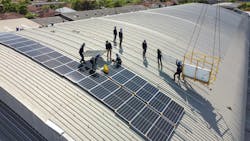Solar energy is flying to record highs at least partially propelled by the renewable incentives and credits from the Inflation Reduction Act (IRA), according to the annual report from the Solar Energy Industries Association (SEIA) and research firm Wood Mackenzie.
The U.S. solar industry added 32.4 GW of new generating capacity in 2023, a 51% rise from the previous year and 37% higher than what was achieved during the record-setting 2021. In fact, new solar made up more than half (53%) of all electric generating capacity added to the grid last year, including utility-scale, community, residential rooftop and microgrid projects.
The majority move by solar in 2023 is truly historic, marking the first time in 80 years that a renewable energy resource accounted for more than half of annual capacity additions, according to SEIA.
“If we stay the course with our federal clean energy policies, total solar deployment will quadruple over the next 10 years,” SEIA president and CEO Abigail Ross Hopper said in a statement. “The Inflation Reduction Act is supercharging solar deployment and having a material impact on our economy, helping America’s solar module manufacturing base grow 89% in 2023.”
Onshoring of Solar Manufacturing
Indeed, solar component manufacturers such as FirstSolar, Trina Solar, 3Sun, Canadian Solar, Hanwha QCells, Longi and others have announced or even start work on plants in the U.S. This “onshoring” of renewable energy manufacturing base could eventually more than triple the domestic module manufacturing capacity, according to reports.
The U.S. solar industry employs close to 250,000 workers, according to a recent IREC report.
SEIA and Wood Mackenzie forecast that total U.S. solar could grow to 673 GW by 2034. This is equivalent to enough electricity, at top generating capacity, to power more than 100 million homes.
Both research entities praised the impact of the IRA and earlier Infrastructure Act, both passed during the Biden administration. A closer supply chain also should mitigate shortages carrying over from the pandemic era, some experts have said.
“A high case for U.S. solar with increased supply chain stability, more tax credit financing and lower interest rates would increase our outlook 17%,” Michelle Davis, head of global solar at Wood Mackenzie and lead author of the “U.S. Solar Market Insight 2023 Year in Review” report, said in the SEIA release.
Momentum Still Dependent on Policy, Fiscal Support?
She cautioned that the outlook, however, could drop 24% with returning supply chain constraints, less tax credit financing and static interest rates. Incentives for onshoring are built into the Inflation Reduction Act language, such as a certain percentage of components being built or assembled in the U.S.
Texas led all states with 6.5 GW in new solar installations last year. California traditionally had led the way but has been superseded by the Lone Star State two times in the past three years, according to the SEIA report.
Check out Think Microgrid's State-by-State Scorecard
Join us at Microgrid 2024 in Baltimore for more on Solar & Storage
New, more restrictive net metering policies in California might impede that state’s momentum in residential solar installations, some say. At the same time, the state is awarding new projects advancing solar, storage and microgrids.
Texas and California are also national leaders in microgrid installations, along with Maryland, where the Microgrid Knowledge 2024 Conference will be held April 22-24 at the Marriott Waterfront along Baltimore’s Inner Harbor.
Early bird discounts currently are available, saving $365 off Microgrid 2024 registration.
Applying Digital Twin Tech at the Microgrid Level








